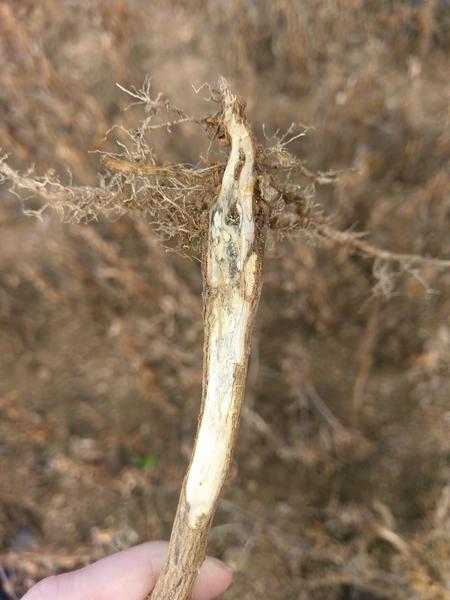Charcoal Rot
- Scientific Name(s)
- Macrophomina phaseolina
- Type
- Disease
- Leaf Condition
- Complete Necrosis, Wilted, Brittle
- Leaf Color
- Patchy Yellow And Brown Areas, Marginal Chlorosis, Interveinal Chlorosis
- Leaf Location
- Entire, Upper, Lower, Young, Mature
- Seed
- Aborted, Shriveled
- Roots
- Stunted, Necrotic
- Main Stem
- Necrotic Spots, Internal Discoloration
- Petioles Condition
- Distorted, Death
- Plant Size
- Stunted
- Field Distribution
- Random, Low Areas, Localized Area
- Prior Environmental
- Rain, High Temp
- Season
- Flowering, Pods Present
- Cropping System
- Soybean Followed By Soybean, Conventional Till, Reduced Till
Introduction
Charcoal rot, caused by the soil- and seed-borne fungus Macrophomina phaseolina, is an economically important disease on soybean (Glycine max L.). M. phaseolina can infect soybean at any growth stage, but more often at the post-flowering stage. It has been reported affecting soybean in Australia, Asia, Africa, Europe, and South and North America. In the United States, the disease is more prevalent in the states of Missouri, Mississippi, Alabama, Illinois, and Indiana. Although it is often found late in the growing season in North Carolina soybeans, it usually does not represent a major threat to production in the state.
Pathogen
Macrophomina phaseolina is an Ascomycete fungus. In culture, the fungus produces grey to black colonies, with abundant irregularly shaped microsclerotia, and colorless hyphae that become light brown with age. On plant stems, small black spots (pycnidia) can be seen irregularly dispersed across the surface.
In the field, the fungus overwinters in crop residue as small resting structures (microsclerotia). The pathogen can survive several years in the soil until a susceptible host and conducive conditions are present for growth. The fungus can also be spread to new fields through contaminated seed and soil materials.
Host Range
M. phaseolina has a broad host range and it has been reported affecting many economically important crops including, common bean, sorghum, sunflower, corn, cotton, and peanut. Other known hosts are forest and fruit trees, medicinal plants, and weed species.
Life Cycle and Favorable Conditions for Disease
Microsclerotia serve as the overwintering structures and initial source of inoculum. As the host roots develop, they release compounds that trigger the fungus to grow from microsclerotia. The fungus penetrates the roots and grows into the vascular tissue. Plant can be infected any time during the growing season, and many plants are infected early in the growing season. Symptoms appear after plants enter reproductive stages or become stressed. Hot, dry conditions favor symptom development, and disease is more severe when plants are under stress. As the pathogen colonizes host tissues, microsclerotia are formed, and survive in crop debris left in the field.
Symptoms and Signs
Symptoms may vary depending on the growth stage at which soybean plants are infected. At the seedling stage, typical symptoms include, brown to dark spots on cotyledons. At the unifoliate leaf stage (VC), circular to oblong, reddish-brown, lesions that eventually turn dark brown to black may be observed. Mid to late season aboveground symptoms include light brown to grey superficial lesions in the stem. A characteristic sign of the pathogen on soybean is the presence of microsclerotia in the vascular tissue, in the pith, and mature and dry pods. Cross-sections of the lower stem and taproot may become streaked with gray hyphae and microsclerotia, giving a marbled appearance (Figure 1).
Management
Crop rotation to non-hosts may help limit survival of the fungus in soils since microsclerotia can survive for several years. Drought-stress mitigation through irrigation when needed may limit severity of disease symptoms. Fungicides are not typically recommended for managing charcoal rot.
Useful Resources
The NC State University Plant Disease and Insect Clinic provides diagnostics and control recommendations.
The NC State Extension Plant Pathology portal provides information on crop disease management.
The North Carolina Agricultural Chemicals Manual provides pesticide information for common diseases of North Carolina. The manual recommendations do not replace those described on the pesticide label, and the label must be followed.
Acknowledgements
This factsheet was prepared by the NC State University Field Crops and Tobacco Pathology Lab in 2020.
- Check out our Facebook and our Twitter!



